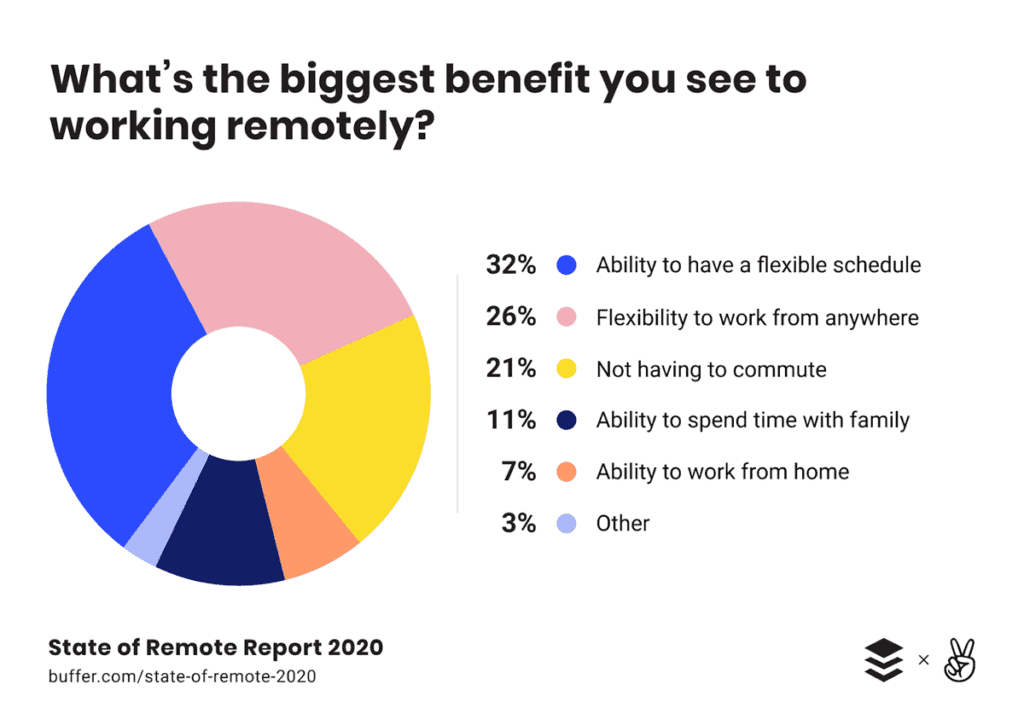Remote Working: Benefits, Challenges, and Best Practices
Working from home has become more popular than ever. With advancements in technology enabling remote collaboration, many businesses are embracing flexible and remote work options. This article explores the rise of remote working, its key benefits and challenges, best practices for employees and employers, and the future outlook of this workforce shift.
Table of Contents
What is Remote Work?

Remote work refers to working outside of a traditional office environment. It encompasses a wide variety of flexible work arrangements, including:
- Working from home: An employee works from a home office or designated workspace within their home
- Coworking spaces: Shared workspaces where remote workers can rent desks or offices
- Telecommuting: Working remotely on either a full-time or hybrid basis
- Digital nomadism: Working while travelling domestically or internationally
The key connecting thread among these arrangements is that employees work independently outside a centralised company office, usually leveraging technology to communicate and collaborate virtually with team members.
The Pandemic-Fuelled Surge in Remote Work
The COVID-19 pandemic necessitated social distancing lockdowns and brought an unprecedented rise of remote work:
- Over 70% of organisations shifted to remote operations in the initial pandemic months.
- By mid-2020, 44% of the US labour force worked full-time from home.
This forced yet rapid shift served as “proof of concept”, demonstrating that remote collaboration at scale is possible through cloud tools like Zoom, Slack, Microsoft Teams and Dropbox.
While some companies expect workers back in the office as norms resume, many are now permanently embracing remote or hybrid policies – realising the cost savings, safety and productivity upside.
Snapshot: US Remote Workforce Stats
- Pre-pandemic (2019): 7% remote workforce
- Mid-2020 peak: 44% remote workforce
- Expected long-term (post-pandemic): 16%-25% will be fully-remote
The remote and hybrid models are here to stay as crucial future work trends. Workers also continue demanding location flexibility – the pandemic revealed a better way of working for many.
| Year | Percentage of Remote Workers |
| 2012 | 2.9% |
| 2016 | 4.3% |
| 2020 | 56% |
| 2022 | 16% |
Why is Remote Work on the Rise? Benefits Driving Adoption

There are several compelling reasons why many employers are shifting towards more flexible remote work options:
1. Access to More Diverse Talent
Opening roles to remote workers mean companies can hire talent from all over a state, country, or even globally. This results in a larger, more diverse talent pool, leading to higher-quality hires.
2. Lower Operational Costs
Maintaining large, centralised office spaces is extremely expensive for rent, utilities, equipment, etc. Most estimates say that companies can save about $11,000 per year for every person who works remotely half the time.
3. Increased Productivity
Numerous studies have shown that employees who work remotely are more productive. Without office distractions or commutes eating into their day, remote employees simply achieve more during their working hours.
- According to one Stanford study, remote workers were 13% more productive on average.
- Another survey found that 65% of managers believe their teams are more productive when working remotely.
4. Improved Employee Satisfaction
Offering work-from-home and remote work options increases job satisfaction as employees appreciate these arrangements' flexibility and autonomy.
- Data shows that employees who spend 60% to 80% of their time working remotely report the highest job satisfaction.
- Another stat is that 80% of workers say having work-from-home options is vital in whether they stay with a company long-term or seek employment elsewhere.
In summary, companies quickly realise that supporting remote work is not only something employees want, but it is also suitable for their bottom line and continued success.
Benefits for Businesses/Organisations
- Reduced real estate costs – Companies can save significantly by downsizing office space with fewer employees onsite full-time.
- Increased talent access – Wider talent pools and recruiting options by removing geographic limitations
- Productivity benefits – Many studies show a marginal to significant rise in remote staff productivity metrics.
- Healthier, happier workers – More sleep, less stress from commuting and greater work-life balance
- Environmental impact – Remote policies help organisations reduce their overall carbon footprint
Why Employees Enjoy Remote Work
From the employee perspective, shifting away from the standard 9 to 5 office routine offers many advantages that directly benefit their lives. The top reasons why employees are drawn to remote work arrangements include the following:
1. No Commuting
For many, commuting to an office daily is physically and mentally exhausting. Working from home eliminates commutes, saving employees time and frustration.
- Pre-pandemic, the average commute time reached almost 30 minutes one way in the US, according to census data.
- That translates to over 200 total commute hours that remote workers get back yearly!
2. Flexible Scheduling
Another major perk of remote work is flexibility in setting your working hours. Remote workers can shift their schedules to match when they are most productive.
- Studies confirm that employees are most energised and efficient earlier in the morning, while afternoons bring mental fatigue and slower thinking.
- Letting workers set schedules that match their natural productive rhythms results in higher job performance.
3. Improved Health
Working from home allows people to take better care of themselves throughout the day, leading to sustained health benefits.
| Statistic |
| 76% report lower stress levels |
| 58% get more exercise |
| 57% eat healthier |
Without time wasted commuting, remote workers also feel less rushed and enjoy more work-life balance. Over 70% say working from home allows them to manage personal and professional responsibilities better.
4. Money Savings
Employees also save hard dollars when working remotely. Top savings come from:
- Lower transportation costs
- Reduced wardrobe expenses
- Decreased food spending since more meals are eaten at home
- There are no childcare costs since caregivers have more flexibility in their schedules
Altogether, employees can bank over $6,000 annually working remotely! Workers crave these positions with all these advantages directly impacting their productivity, health, happiness, and wallets.
Benefits for Remote Employees
- No commute, more sleep – Employees get back precious hours without travel to an office
- Work from anywhere – Autonomy to work from home or locations of choice (like a vacation!)
- Family time – Better work-life balance and time with loved ones
- Cost savings – Reduced costs related to commuting, parking, lunch, etc.
- Flexibility & control – – Over schedules, taking breaks when needed and structuring work in their style
With businesses and talent realising the tangible upsides, remote and hybrid policies create a compelling win-win arrangement.
Challenges and Downsides to Remote Work

However, despite its many upsides, working remotely also comes with some unique pain points for both companies and people:
Technological Hiccups
Collaborating virtually is still heavily reliant on web conferencing tools and other technology. Spotty internet connections, call audio issues, or software problems can hinder team workflows.
- One study found that two-thirds of remote workers lose productivity to technical problems weekly.
- Outdated company cybersecurity policies often disregard remote equipment, leading to vulnerable data and possible breaches.
Lack of Face-to-Face Interaction
Many enterprise leaders and some employees feel disconnected from their teams while working remotely daily. Something is only possible with those face-to-face collisions that spark creativity or rapport-building social interactions over lunch.
On average, people working completely remotely have the following:
- 18% fewer interactions with coworkers
- 12% fewer interactions with outside business connections
It takes a conscientious effort to prevent remote workers from feeling isolated long term.
Maintaining Company Culture
Along with fewer daily interactions, preserving a cohesive and healthy company culture can suffer if remote work becomes the default.
- Unique sub-cultures and fragmented employee experiences that do not fully align with leadership's vision and values may emerge.
- Only 22% of companies have documented practices in place to support culture building actively among remote staff.
Without shared norms defining expected behaviours and regularly bringing everyone together, company culture tends to deteriorate in dispersed teams, leading to lower engagement and job satisfaction.
Work-Life Boundary Issues
Working at home also makes maintaining a healthy mental separation of work from personal time more difficult. Remote employees often have issues fully disengaging at the end of their scheduled hours.
- 65% report struggling to stop thinking about or doing work tasks after hours
- 60% have difficulties staying motivated and feeling productive while working at home
Ongoing work-life balancing challenges contribute to increased risk for anxiety, depression and burnout among the remote workforce.
In light of these common remote work pitfalls impacting operations, leadership should take proactive mitigation steps to protect company health when expanding flexible location policies long-term.
Best Practices for Remote Work Success

How should organisations evolve their policies, procedures, tools, and leadership styles to build productive and satisfied dispersed workforces? Based on extensive reviews of current remote work setups and analysis of what makes them function well over the long haul, the following core best practices emerge:
1. Modernise Technology Stacks
Ensure all remote workers have enterprise-grade hardware and the latest software needed for flawless virtual collaborations, including:
| Hardware | Software |
| Fast laptops | Zoom or Teams for video conferences |
| Dual monitors | Slack/Teams for instant messaging |
| Docking station | G suite, Office 365, and Dropbox for cloud content collaboration |
| Headset with microphone | Project management systems like Asana |
Also, confirm home networks meet security standards. Provide stipends if employees need to upgrade personal equipment.
2. Train Managers
Hold dedicated virtual workshops for anyone managing remote reports focused on:
- Maintaining team cohesion from afar
- Preventing isolation by scheduling regular check-ins
- Monitoring work-life balance and signs of burnout
- Giving actionable feedback virtually
3. Increase In-Person Touchpoints
Counteract reduced daily interactions by bringing remote workers together periodically, including:
- Hosting annual or bi-annual offsite networking events
- Planning regular team trips to the primary office
- Rotating face-to-face brainstorming sessions
4. Digitise Workflows
Reduce productivity lags from technical issues by ensuring all critical workflows happen on secure enterprise-ready platforms. Provide self-serve IT help tickets for any system problems.
5. Send Clear Guidelines
To promote better work-life boundaries at home, leadership should send clear remote work policies on best practices like:
- Defining ́core collaboration hours ́ when all employees should be available
- Encouraging taking regular breaks during shifts
- Discouraging off-hour communications
- Tracking employee engagement for signs of burnout
Following structured remote work guidelines clarifies staff while adding accountability on both sides.
If appropriately executed using standards like these, companies can implement successful and sustainable work-from-anywhere programs, allowing leadership, operations, culture and employees to thrive!
Remote Work Statistics and Future Trends

Various studies and labour data reveal interesting statistics that showcase the present-day prevalence along with the future outlook for remote work:
- 80% of global HR leaders report productivity being the same (67%) or higher (13%) with remote employees versus levels before the pandemic
- 46% of employees say they would consider leaving a job that didn’t offer flexible remote work options
- 54% would take a pay cut for greater location flexibility
- 63% don’t want to return to an office full-time ever again
- 83% of company leaders plan on permitting remote work to some capacity moving forward
The message is clear – flexible and hybrid arrangements are here to stay as a central future of work trends, with constantly advancing digital tools making distributed collaboration ever easier.
While fully distributed companies will continue emerging, the sweet spot that appears to suit most workers and leaders is a hybrid model blending the best of both worlds – human connections of office interactions with the focus and autonomy benefits of working from home.
Key Takeaways and Conclusions
The remote work revolution by the pandemic has spotlighted the enormous upsides of location-flexible policies, paving the way for permanent evolution in how many organisations operate and employees work.
With suitable policies, infrastructure setup and personal habits to safeguard productivity, worker wellbeing and company culture, distributed teams and hybrid or full-time remote arrangements can yield happier, healthier and more motivated staff – along with savings on real estate costs and more comprehensive talent access for employers.
While the model poses some unique pitfalls, the benefits far outweigh the challenges of this work paradigm shift. With constant technology advancements, alongside workers demanding location flexibility, remote and hybrid arrangements will quickly emerge as the future of work for most companies.
Rather than resisting the tide, the wise path forward is to embrace flexible policies and equip staff with the right tools and training while optimising leadership, workflows and organisational culture to maximise the remote model's productivity and real estate savings.
The location-agnostic 21st-century workforce is here to stay – presenting an exciting horizon of possibilities for businesses and talent by breaking geographical barriers and enabling new working styles.
Frequently Asked Questions (FAQs) on Remote Working Trends:
What percentage of the workforce will be fully remote post-pandemic?
Early projections estimate that about 25-30% of the workforce will stay fully remote after the pandemic, with a more significant majority shifting into hybrid remote/office roles long term.
What jobs allow for fully remote work easiest?
Roles in IT, computer science, finance, marketing, customer service, design, and writing/editing generally translate well into permanent remote positions requiring little on-site face time.
Is working remotely better for introverts or extroverts?
Introverts often thrive with remote work, given reduced social interactions and alone time to recharge while working autonomously. However, extroverts can do well, too, but may need to be more proactive about scheduling social-based activities with coworkers to feel energised.
What is a typical remote worker personality trait?
Successful remote workers tend to be very disciplined, self-directed, and skilled at time management since they lack direct oversight while working independently at home.
What is the #1 remote worker frustration?
Top remote work complaints relate to problems with technology, including unreliable home wi-fi, audio technical difficulties during virtual meetings, and juggling multiple collaboration platforms. Addressing these tech issues helps remote workers' happiness immensely!
